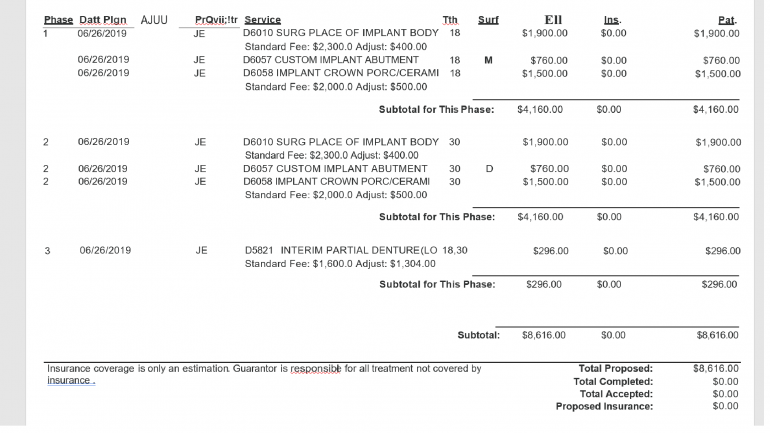
D9120: Fixed partial denture sectioning
Dental Code D9120 refers to the procedure known as fixed partial denture sectioning. This dental treatment is performed to repair or modify a fixed partial denture, commonly known as a dental bridge. It involves dividing the existing bridge into multiple sections to allow for adjustments or repairs. Overall, the purpose of Dental Code D9120 is to restore the integrity and functionality of a fixed partial denture. By sectioning the bridge, making necessary adjustments, and reassembling it, this procedure aims to provide patients with an improved dental appliance that enhances their oral health and confidence in their smile.
Detailed Information about the Procedure
Dental Code D9120, fixed partial denture sectioning, is a procedure that involves dividing an existing dental bridge into sections to allow for adjustments or repairs. The process begins with a thorough evaluation of the bridge's condition, assessing factors such as fit, stability, and overall integrity. To ensure patient comfort, local anesthesia is administered, and isolation methods may be used to protect surrounding teeth and gums.
Using specialized dental instruments, the dentist carefully sections the bridge, following precise guidelines to create appropriately sized and shaped components. The next step involves making necessary adjustments or modifications based on the specific issues identified during the evaluation. This may include reshaping or trimming certain areas of the bridge to improve fit, aesthetics, or functionality. Defects or damage are also addressed at this stage.
Evaluation and Assessment
Before proceeding with fixed partial denture sectioning, a comprehensive evaluation of the dental bridge is conducted by the dentist. This evaluation includes assessing the condition of the bridge, identifying any issues or defects, and determining the appropriate modifications required. The dentist examines the fit, stability, and overall integrity of the bridge to decide whether sectioning is necessary.
Anesthesia and Isolation
To ensure the patient's comfort during the procedure, local anesthesia is administered by the dentist to numb the area around the dental bridge. This prevents any pain or discomfort during the sectioning process. Additionally, a dental dam or other isolation methods may be used to protect the surrounding teeth and gums from debris or contamination.
Sectioning of the Dental Bridge
Once the anesthesia has taken effect, the dentist proceeds to carefully section the dental bridge into separate components. This is typically done using specialized dental instruments such as diamond burs or rotary tools. The sections are created in a way that allows for easy adjustment or repair of the bridge. The dentist follows precise guidelines to ensure that the sections are appropriately sized and shaped.
Adjustment and Modification
After the dental bridge has been divided into sections, the necessary adjustments or modifications are made by the dentist. This step depends on the specific issues identified during the evaluation. It may involve reshaping or trimming certain areas of the bridge to improve fit, aesthetics, or functionality. Any defects or damage are also addressed at this stage. The dentist carefully analyzes the bridge sections to determine the most effective modifications required to achieve the desired outcome.
Reassembling and Bonding
Once the required adjustments have been made, the sections of the dental bridge are reassembled by the dentist. This ensures that the bridge maintains its structural integrity and stability. The dentist carefully aligns the sections and uses dental adhesives or cements to bond them together. This bonding process is crucial to ensure the long-term success of the repaired or modified bridge.
Bite Adjustment and Polishing
To ensure proper occlusion (bite) and alignment, a bite adjustment is performed by the dentist. This involves checking and adjusting the contact between the upper and lower teeth when the patient bites down. The dentist makes any necessary modifications to optimize the fit and function of the dental bridge. Finally, the bridge is polished to achieve a smooth and natural-looking finish. Polishing enhances the aesthetics of the bridge and helps prevent plaque accumulation.
Summary of Dental Code D9120
Dental Code D9120, fixed partial denture sectioning, is a procedure performed to repair or modify a dental bridge. It involves dividing the bridge into sections, making necessary adjustments, and then reassembling the components. The process requires a comprehensive evaluation, anesthesia, and isolation to ensure patient comfort. Specialized dental instruments such as diamond burs or rotary tools are used to carefully section the bridge. The dentist then performs adjustments to improve fit, aesthetics, and functionality. The reassembled bridge is bonded using dental adhesives or cements to ensure structural integrity. A bite adjustment is performed to optimize occlusion, and the bridge is polished for a natural-looking appearance. This dental procedure aims to restore the integrity and functionality of a fixed partial denture, providing patients with improved oral health and a confident smile.
Dr. BestPrice – where affordability meets accessibility in dental care. It's time to prioritize your smile. Don't spend too much money on your dental care, compare prices and make the best choice!
